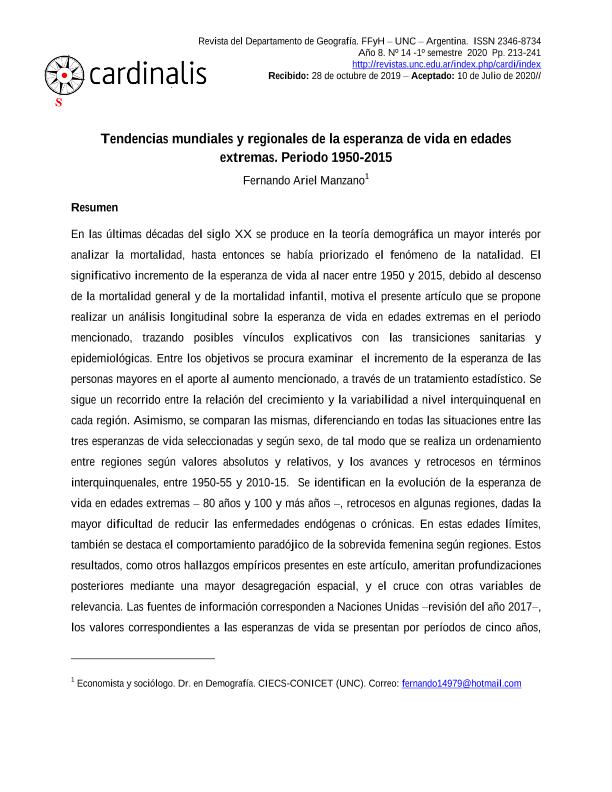Mostrar el registro sencillo del ítem
dc.contributor.author
Manzano, Fernando

dc.date.available
2020-09-11T02:36:57Z
dc.date.issued
2020-06
dc.identifier.citation
Manzano, Fernando; Tendencias mundiales y regionales de la esperanza de vida en edades extremas: Periodo 1950-2015; Universidad Nacional de Córdoba. Facultad de Filosofía y Humanidades. Departamento de Geografía; Cardinalis; 8; 14; 6-2020; 213-241
dc.identifier.issn
2346-8734
dc.identifier.uri
http://hdl.handle.net/11336/113760
dc.description.abstract
En las últimas décadas del siglo XX se produce en la teoría demográfica un mayor interés por analizar la mortalidad, hasta entonces se había priorizado el fenómeno de la natalidad. El significativo incremento de la esperanza de vida al nacer entre 1950 y 2015, debido al descenso de la mortalidad general y de la mortalidad infantil, motiva el presente artículo que se propone realizar un análisis longitudinal sobre la esperanza de vida en edades extremas en el periodo mencionado, trazando posibles vínculos explicativos con las transiciones sanitarias y epidemiológicas. Entre los objetivos se procura examinar el incremento de la esperanza de las personas mayores en el aporte al aumento mencionado, a través de un tratamiento estadístico. Se sigue un recorrido entre la relación del crecimiento y la variabilidad a nivel interquinquenal en cada región. Asimismo, se comparan las mismas, diferenciando en todas las situaciones entre las tres esperanzas de vida seleccionadas y según sexo, de tal modo que se realiza un ordenamiento entre regiones según valores absolutos y relativos, y los avances y retrocesos en términos interquinquenales, entre 1950-55 y 2010-15. Se identifican en la evolución de la esperanza de vida en edades extremas – 80 años y 100 y más años –, retrocesos en algunas regiones, dadas la mayor dificultad de reducir las enfermedades endógenas o crónicas. En estas edades límites, también se destaca el comportamiento paradójico de la sobrevida femenina según regiones. Estos resultados, como otros hallazgos empíricos presentes en este artículo, ameritan profundizaciones posteriores mediante una mayor desagregación espacial, y el cruce con otras variables de relevancia. Las fuentes de información corresponden a Naciones Unidas –revisión del año 2017–, los valores correspondientes a las esperanzas de vida se presentan por períodos de cinco años, siendo las regiones seleccionadas: Europa, América Latina y el Caribe, Asia, África, América del Norte y Oceanía.
dc.description.abstract
In the last decades of the XXth century there takes place in the demographic theory a major interest to analyze the mortality, till then the phenomenon of the birthrate had been prioritized. On having been born between 1950 and 2015, due to the descent of the general mortality and of the infant mortality, the significant increase of the life expectancy motivates the present article that proposes to realize a longitudinal analysis on the life expectancy in extreme ages in the mentioned period, planning possible linked explanatory with the transitions sanitary ware and epidemiologic. Between the targets one tries to examine the increase of the hope of the elderly in the contribution to the mentioned increase, doing a statistical treatment following a trip between: the relation between the growth and the changeability at interfive-year level in every region and the comparison between the same ones – differing in all the situations between three chosen life expectancies and according to sex – the arranging between regions according to the absolute and relative values, and the advances and regressions in interfive-year terms between 1950-55 and 2010-15. Regressions are identified in the evolution of the life expectancy in extreme ages – as they are 80 years old and 100 and more years – in some regions, given the biggest difficulty of reducing the endogenous or chronic illnesses. In these extreme ages, also one emphasizes the paradoxical behavior of the feminine sobrevida as regions. These results, like other present empirical finds in this article, they deserve later deepening by means of a major spatial disintegration, and the crossing with other relevancy variables. The information sources correspond to United Nations – review of the year 2017 – the values corresponding to the life expectancies appear for periods of five years, being the chosen regions: Europe, Latin America and the Caribbean Sea, Asia, Africa, North America and Oceania.
dc.format
application/pdf
dc.language.iso
spa
dc.publisher
Universidad Nacional de Córdoba. Facultad de Filosofía y Humanidades. Departamento de Geografía
dc.rights
info:eu-repo/semantics/openAccess
dc.rights.uri
https://creativecommons.org/licenses/by-nc-sa/2.5/ar/
dc.subject
ESPERANZA DE VIDA
dc.subject
MORTALIDAD
dc.subject
SOBREVIDA FEMENINA
dc.subject.classification
Demografía

dc.subject.classification
Sociología

dc.subject.classification
CIENCIAS SOCIALES

dc.title
Tendencias mundiales y regionales de la esperanza de vida en edades extremas: Periodo 1950-2015
dc.title
Global and regional trends in life expectances in extreme ages: Period 1950- 2015
dc.type
info:eu-repo/semantics/article
dc.type
info:ar-repo/semantics/artículo
dc.type
info:eu-repo/semantics/publishedVersion
dc.date.updated
2020-09-03T19:19:02Z
dc.journal.volume
8
dc.journal.number
14
dc.journal.pagination
213-241
dc.journal.pais
Argentina

dc.journal.ciudad
Córdoba
dc.description.fil
Fil: Manzano, Fernando. Consejo Nacional de Investigaciones Científicas y Técnicas. Centro Científico Tecnológico Conicet - Tandil. Instituto de Geografía, Historia y Ciencias Sociales. Universidad Nacional del Centro de la Provincia de Buenos Aires. Instituto de Geografía, Historia y Ciencias Sociales; Argentina
dc.journal.title
Cardinalis
dc.relation.alternativeid
info:eu-repo/semantics/altIdentifier/url/https://revistas.unc.edu.ar/index.php/cardi/article/view/29873
Archivos asociados
